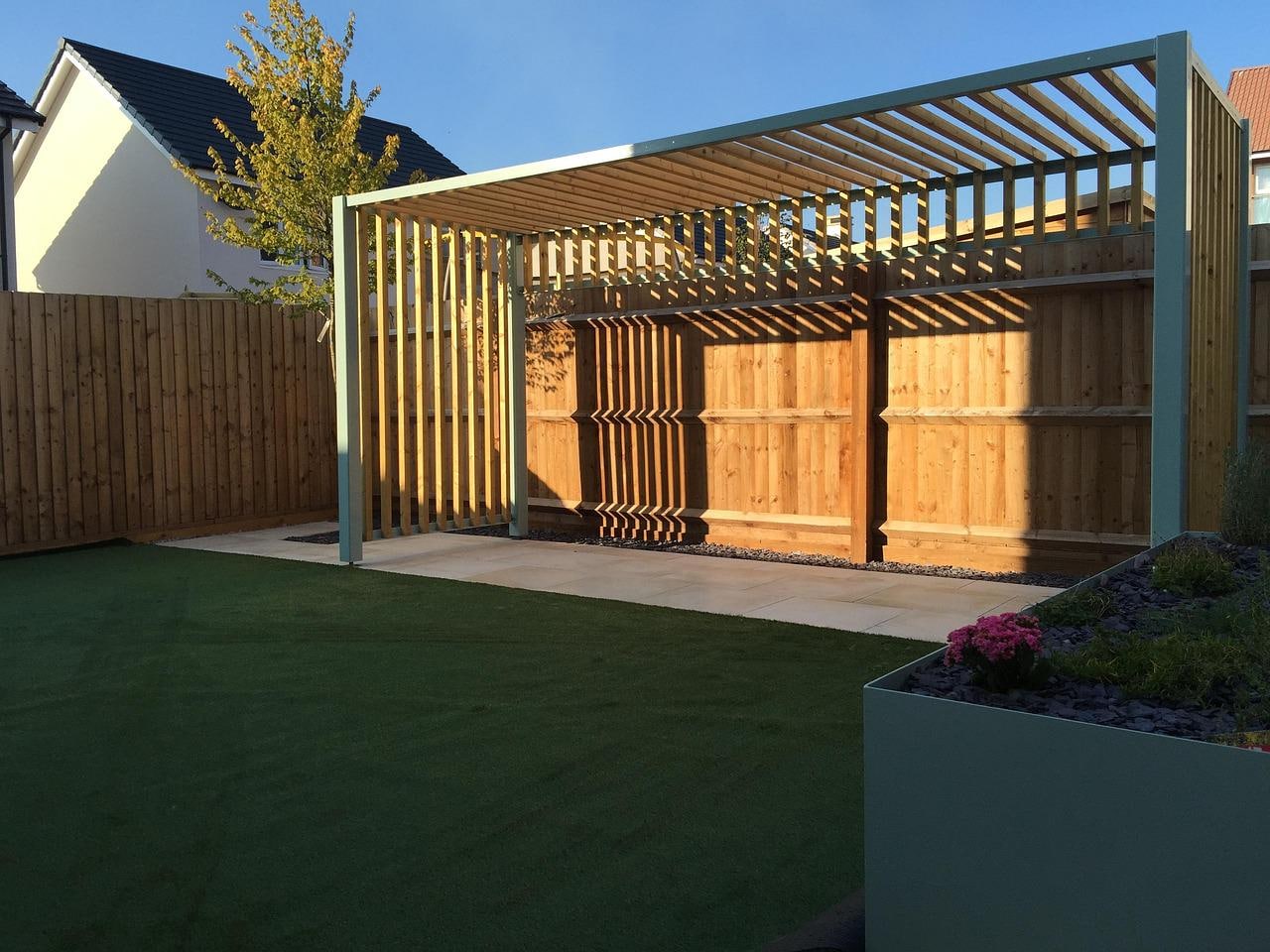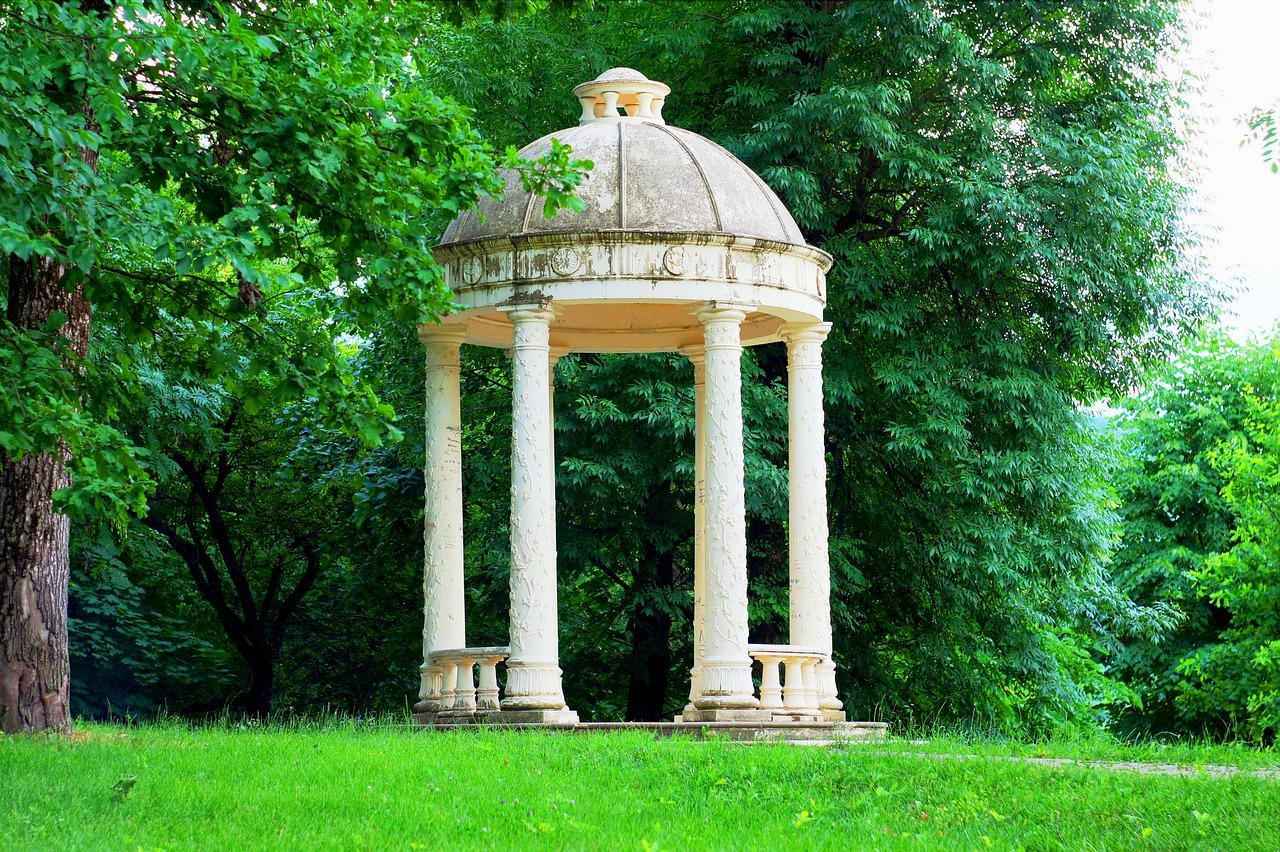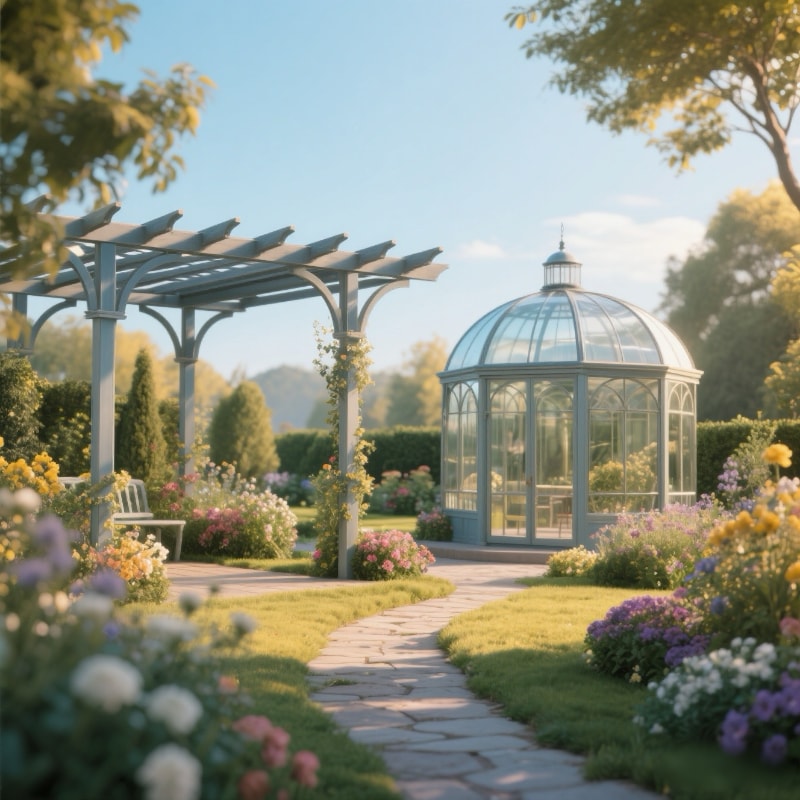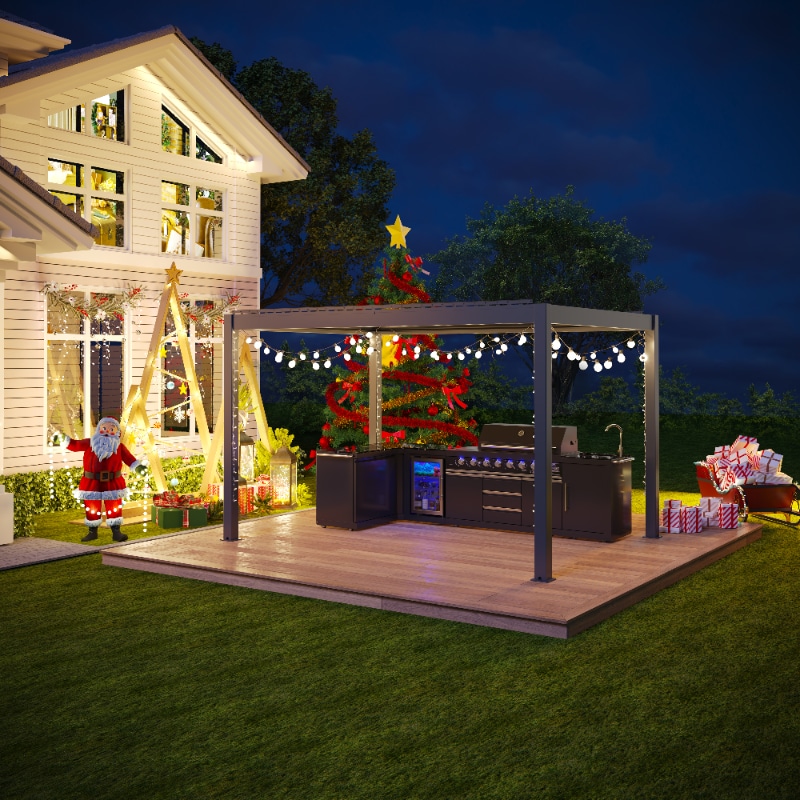When it comes to upgrading your backyard, few additions are as impactful as a pergola or gazebo. But which one is right for your space? In this guide, we compare the two structures in terms of design, function, and value to help you make the best decision.
What Is a Pergola?
A pergola is an outdoor garden structure designed to offer a blend of shade and aesthetic charm. With origins tracing back to Renaissance Italy, pergolas were once used to create serene, covered passageways in gardens, seamlessly blending nature with architectural elegance. The word "pergola" comes from the Latin term pergula, which refers to a projecting eave or a sheltering structure. Today, pergolas are popular in backyards and gardens, providing an inviting outdoor space that's neither fully enclosed nor entirely exposed to the elements.

The structure of a pergola is relatively simple yet striking. Typically, it consists of four vertical posts that support horizontal beams. These beams may be arranged in a variety of patterns, such as crisscrossed or louvered, to create the characteristic open roof that many people associate with pergolas. The open roof is made of parallel slats or beams, which allow sunlight to filter through while providing varying degrees of shade depending on their spacing.
When it comes to materials, traditional pergolas are often made from wood, which offers a classic and natural look. Popular choices include timber such as cedar or pine, both of which are known for their durability and ability to withstand outdoor conditions. In more modern designs, however, pergolas are commonly built with industrial-grade aluminum, which is lightweight, rust-resistant, and low-maintenance. Aluminum pergolas are often powder-coated in a variety of colors to suit contemporary garden styles.
A key characteristic of the pergola is its flexibility. While it doesn't have a solid, permanent roof like a gazebo, many pergolas can be equipped with retractable or louvered roofs. These roofs allow homeowners to adjust the amount of sunlight or shade they want, providing customizable comfort. Some models even come with side panels for extra protection from wind or rain.

What Is a Gazebo?
A gazebo is a freestanding outdoor structure with a solid roof and open sides, designed to offer both shelter and style. Unlike a pergola, which typically features an open or slatted roof, a gazebo provides full overhead protection from sun and rain, making it a comfortable year-round retreat in the garden or backyard. Gazebos have a long history, with roots tracing back to 18th-century Britain, where they were seen as garden pavilions or belvederes built to "gaze" at scenic views—hence the name.
Traditionally, gazebos are built in symmetrical shapes, often hexagonal or octagonal, with a roof that mimics residential architecture. This roof can feature ornate details such as wooden shingles, latticework, or finials, giving the structure a refined and often vintage charm. Classic designs often include railings or partial walls, while some modern versions come with full walls, built-in seating, or even screened windows to keep bugs at bay.
Materials used for gazebos vary widely, ranging from natural timber that brings warmth and rustic appeal, to powder-coated metal or vinyl for a more contemporary, low-maintenance option. Many gazebos are raised slightly off the ground and include a floor, adding to their pavilion-like feel.
Whether placed in a private garden or a public park, a gazebo acts as a striking focal point. It invites relaxation, provides shelter for outdoor dining or gatherings, and can even serve as a romantic setting for weddings or special events. With their solid roof, defined structure, and architectural elegance, gazebos offer a more enclosed, room-like outdoor experience—ideal for those looking to blend function with timeless beauty.
Differences Between a Pergola and a Gazebo
Some people may assume that a pergola and a gazebo are the same thing—but that's not the case. While both structures are excellent additions to outdoor spaces, they differ significantly in terms of purpose, structure, materials, and overall design. Here are the key differences between the two:
1. Roof Design and Shade
The most noticeable difference lies in the roof structure. Pergolas feature an open roof design made of horizontal slats or louvers, offering partial shade and allowing dappled sunlight to filter through. Some modern pergolas even have adjustable or retractable roofs, giving you more control over sun and rain exposure.
Gazebos, on the other hand, have fully enclosed, often pitched roofs that provide complete protection from the elements. This makes them ideal for all-weather use, particularly in areas prone to heavy rain or strong sun.
2. Function and Flexibility
Pergolas are incredibly flexible. They can be freestanding or attached to your home, acting as an extension of your indoor space. They're perfect for patios, walkways, or outdoor dining areas where you want a blend of light, air, and structure.
Gazebos are always freestanding and typically larger, making them a centerpiece for gatherings or special occasions like weddings or outdoor parties. They often include built-in floors, railings, or benches for a more enclosed, room-like feel.
3. Structure and Footprint
Pergolas are usually rectangular and built on existing surfaces like patios or decks. They don’t require additional flooring, which makes installation simpler and less invasive.
Gazebos are more elaborate and often come in hexagonal or octagonal shapes. Because they’re raised and include flooring, they need more ground preparation and tend to occupy more space, which might not suit smaller gardens.
4. Materials and Maintenance
Both structures can be made from wood, metal, or vinyl. Pergolas, particularly aluminum models, are low-maintenance and resistant to rust and fading. Wooden pergolas may require occasional sealing or staining.
Gazebos—especially wooden ones—tend to need more upkeep due to their full roofs and detailed construction. However, they offer greater durability and year-round protection when properly maintained.
5. Cost and Installation
Pergolas are generally more budget-friendly, with prices starting as low as $600 and going up depending on size, material, and features. They're also considered more DIY-friendly due to their simpler structure.
Gazebos tend to be more expensive, with costs ranging from $450 to $17,000, depending on complexity and material. They require more materials and labor due to features like flooring, roofing, and ornate finishes.
6. Style and Home Integration
Pergolas offer a sleek, minimalist look that complements modern homes and contemporary gardens. Their adaptable design allows you to customize finishes, roof types, and accessories to match your outdoor space.
Gazebos exude classic charm and work best in more traditional or spacious landscapes. Their more decorative structure can make a strong visual statement but may feel out of place in smaller or ultra-modern gardens.
| Feature | Pergola | Gazebo |
| Roof Type | Slatted or adjustable; partial shade | Solid, enclosed; full shade/rain cover |
| Structure | Freestanding or attached | Freestanding only |
| Shape | Usually rectangular | Typically round, hexagonal, or octagonal |
| Material Options | Wood, aluminum, vinyl | Wood, metal, vinyl |
| Flooring Needed | No (installed on existing surface) | Yes (requires raised floor) |
| Maintenance | Low to moderate | Moderate to high |
| Cost Range | $600 – $12,000 | $450 – $17,000 |
| Best For | Modern patios, walkways, extensions | Larger gardens, covered seating areas |
Pergola vs Gazeb: Pros and Cons
1. Pros and Cons of Pergolas
Pros:
- Cost-Effective & Easy to Build: Pergolas typically have a simpler design and require fewer materials, making them more budget-friendly and quicker to install.
- Design Flexibility: Available in wood, vinyl, or aluminum, pergolas come in a range of styles to suit modern or traditional spaces.
- Perfect for Open-Air Features: Their open design makes them ideal for incorporating fire pits, outdoor bars, or pizza ovens.
- Adds Property Value: A well-designed pergola can enhance your outdoor living space and increase your home’s resale appeal.
Cons:
- Limited Weather Protection: The slatted or louvered roof offers partial shade, but most of them don't provide full shelter from rain or harsh sun.
- No Floor or Screens: Most pergolas are built directly onto an existing deck or patio, with no integrated floor or insect protection.
- Not Ideal for Electric Add-ons: Their lighter structure makes it harder to integrate wiring for lights or fans.
- Less Durable in Harsh Climates: Wooden pergolas especially require regular maintenance and may not hold up as well in extreme weather.
2. Pros and Cons of Gazebos
Pros:
- Full Shelter: With a solid roof and often built-in flooring, gazebos provide complete protection from the sun and rain, making them usable in nearly any weather.
- Insect Protection: Many gazebos can be screened in, offering a more enclosed, bug-free outdoor experience.
- Electric Compatibility: Their sturdy build allows for safe installation of electric lights, ceiling fans, or even speakers.
- Elegant, Classic Design: Gazebos offer a timeless, sophisticated look—especially appealing in larger yards with lush landscaping.
- Increases Home Value: Like pergolas, gazebos are a sought-after backyard feature that can add real estate value.
Cons:
- Higher Cost: Gazebos are more expensive to build due to their enclosed roofs, added materials, and often complex designs.
- Takes Up More Space: Their larger, rounder footprint may not be ideal for smaller yards.
- Less Open-Air Adaptability: Unlike pergolas, gazebos are not as well-suited to open features like fire pits or bars.
- May Feel Dated to Some: While elegant, some may see gazebos as too traditional or less aligned with modern outdoor aesthetics.

Gazebo vs Pergola: Which One is Better?
When choosing between a pergola and a gazebo for your backyard, there’s no one-size-fits-all answer. The better option depends on your needs, preferences, and how you intend to use the space. Let’s explore the key factors to help you decide.
1. Appearance – Tie
Both pergolas and gazebos offer beautiful design options. Pergolas provide a modern, minimalist aesthetic with clean lines and open-air appeal—perfect for contemporary landscapes. Gazebos, on the other hand, add a classic, Victorian charm and often serve as decorative focal points. Choose based on your style preferences.
2. Weather Protection – Gazebo
If full protection from sun, wind, and rain is a top priority, gazebos are the clear winner. Their solid roof and optional walls or screens provide complete shelter. Pergolas, with open or slatted roofs, offer partial shade at best.
3. Flexibility and Customization – Pergola
Pergolas shine when it comes to versatility. From bioclimatic aluminum models with adjustable louvers to DIY kits that fit any space, they adapt easily to different needs. You can use them as connectors between structures, garden walkways, or open-air lounges with vines or lights.
4. Ease of Installation – Pergola
Pergolas are generally easier and quicker to install, especially with pre-made kits. Most DIYers can manage the setup. Gazebos, due to their complex roof and flooring, typically require professional installation.
5. Budget – Pergola
Pergolas are more cost-effective overall. They require fewer materials and less labor, making them ideal for homeowners on a tighter budget. Gazebos, with their enclosed designs, cost more both in materials and installation.
6. Durability and Longevity – Gazebo
When built with the same material, gazebos tend to last longer thanks to their sturdy enclosed design. Their roofs and flooring offer better protection from weather and wear over time.
7. Insect Protection – Gazebo
For bug-free comfort, gazebos can be screened in or enclosed—perfect for outdoor dining or evening gatherings. Pergolas, being open structures, don’t offer this protection.
If you're looking for a stylish, budget-friendly way to define a space and enjoy partial shade, a pergola is a great option. However, if you’re willing to invest more for better weather protection, added comfort, and a timeless look, a gazebo may be the right choice.

Pergola & Gazebo: Design Ideas and Inspiration
Whether you're aiming for a cozy backyard retreat or a stylish entertainment zone, both pergolas and gazebos offer endless design potential. Here are some inspiring ideas to help you decide which structure best suits your outdoor space.
1. Pergola Ideas
- Modern Minimalism Choose a sleek aluminum pergola with a louvered roof for adjustable shade. Pair it with neutral outdoor furniture and clean lines for a sophisticated, low-maintenance patio.
- Garden Escape Let nature take center stage with a wooden pergola draped in climbing vines like wisteria or jasmine. Add a bench swing or a reading nook underneath for a tranquil hideaway.
- Dining Under the Stars Install string lights across the beams of your pergola and place a long dining table below. Perfect for summer dinners and evening drinks.
- Built-in Outdoor Bar Attach a pergola to your house and use it to shelter an outdoor kitchen or bar. Add bar stools and shelves for a resort-style setup.
2. Gazebo Ideas
- Classic Victorian Charm Opt for a white octagonal wooden gazebo with a shingled roof and decorative trim. Place it among lush landscaping for an elegant, timeless garden feature.
- Screened Retreat Choose a screened-in gazebo with comfortable seating, ceiling fans, and lighting—ideal for relaxing evenings without worrying about insects.
- Lakeside or Poolside Lounge Position a gazebo near a water feature or pool for a shaded place to unwind, complete with chaise lounges or a daybed.
- Romantic Wedding Spot Gazebos make perfect ceremonial spaces. Add sheer drapery, flowers, and soft lighting for an unforgettable setting.
Conclusion
Both pergolas and gazebos bring beauty and purpose to your backyard, but the best choice depends on your needs. Whether you prefer an open, modern feel or a fully sheltered retreat, this guide helps you find the structure that fits your lifestyle and budget.
FAQs About Pergolas & Gazebos
1. Are metal or aluminum pergolas and gazebos durable?
Yes, aluminum and metal options are highly durable and low-maintenance. They resist rust, fading, and weather damage better than untreated wood, making them ideal for year-round outdoor use.
2. What size pergola or gazebo should I choose?
It depends on your available space and intended use. Common sizes include 10x10 or 10x8 feet for compact patios, while larger yards can accommodate 12x14 or more. Always measure your space before purchasing.
3. What’s better for a hot tub: pergola or gazebo?
A gazebo is generally better for covering a hot tub as it provides more protection from the elements and can offer privacy. However, a pergola with curtains or retractable roofs can also be adapted for this use.
4. Can I add electricity to a pergola or gazebo?
Gazebos are more suitable for electric wiring due to their solid structure. While some pergolas can be wired, it’s more challenging and often not recommended for basic wooden or open-frame models.
5. Can a pergola be converted into a gazebo?
While possible, converting a pergola into a gazebo requires significant structural changes—like adding a solid roof, flooring, and possibly walls or screens. In most cases, it’s more efficient to build a gazebo from scratch.
6. Are there combo designs that include both a pergola and a gazebo?
Yes, hybrid structures exist that combine the open-air feel of a pergola with the shelter of a gazebo. These designs are perfect for flexible outdoor living areas that balance shade and coverage.